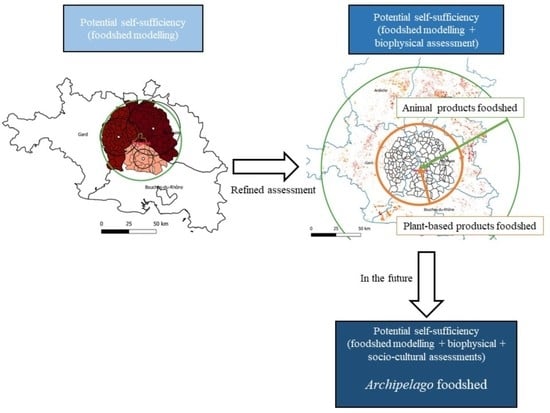Foodshed, Agricultural Diversification and Self-Sufficiency Assessment: Beyond the Isotropic Circle Foodshed—A Case Study from Avignon (France)
Abstract
:1. Introduction
2. Materials and Methods
2.1. Study Aea
2.2. Application of the MFSS Model for the Avignon Foodshed Assessment: Food Land Footprint and the Potential Self-Sufficiency of the Foodshed
2.3. Materials Used for the Current Crop Production and Self-Sufficiency Level Assessment of Plant-Based Products
2.4. Materials Used for the Food Land Footprint and Foodshed Assessment of Animal Products
2.5. Methodology Used for the Assessment
3. Results
3.1. Foodshed Assessment and Potential Self-Sufficiency for the Proposed Foodshed
3.2. Current Crop Production and Self-Sufficiency of Plant-Based Products
3.3. Current Livestock Production and Potential Self-Sufficiency of Animal Products
3.4. Assessment of the Expanded Foodshed for Animal Products
4. Discussion
4.1. The Spatial Configuration of the Foodshed, Taking into Account Crop Diversification Questions
4.2. Foodshed and Self-Sufficiency Assessment: From the Isotropic Circle to the Archipelago Foodshed
4.3. Potential Application of the Methodology to Other Study Cases
4.4. Limitations of the Study
5. Conclusions
Supplementary Materials
Author Contributions
Funding
Institutional Review Board Statement
Informed Consent Statement
Data Availability Statement
Acknowledgments
Conflicts of Interest
References
- Deverre, C.; Traversac, J.-B. Local Food: A Concret Utopia. Métropolitiques. 2012. Available online: https://metropolitiques.eu/Local-food-a-concrete-Utopia.html (accessed on 19 January 2021).
- Hinrichs, C.C. Regionalizing food security? Imperatives, intersections and contestations in a post-9/11 world. J. Rural Stud. 2013, 29, 7–18. [Google Scholar] [CrossRef]
- Moragues-Faus, A. Distributive food systems to build just and liveable futures. Agric. Hum. Values 2020, 37, 583–584. [Google Scholar] [CrossRef] [PubMed]
- Carey, J. Who Feeds Bristol? Towards a Resilient Food Plan; Bristol City Council: Bristol, UK, 2011. [Google Scholar]
- Pradhan, P.; Kriewald, S.; Costa, L.; Rybski, D.; Benton, T.G.; Fischer, G.; Kropp, J.P. Urban food systems: How regionalization can contribute to climate change mitigation. Env. Sci. Technol. 2020, 54, 10551–10560. [Google Scholar] [CrossRef] [PubMed]
- Vicente-Vicente, J.L.; Piorr, A. Can a shift to regional and organic diets reduce greenhouse gas emissions from the food system? A case study from Qatar. Carbon Balance Manag. 2021, 16, 2. [Google Scholar] [CrossRef]
- Doernberg, A.; Horn, P.; Zasada, I.; Piorr, A. Urban food policies in German city regions: An overview of key players and policy instruments. Food Policy 2019, 89, 101782. [Google Scholar] [CrossRef]
- Piorr, A.; Zasada, I.; Doernberg, A.; Zoll, F.; Ramme, W. Research for AGRI Committee—Urban and Peri-Urban Agriculture in the EU; European Parliament: Brussels, Belgium, 2018. [Google Scholar]
- Béné, C.; Oosterveer, P.; Lamotte, L.; Brouwer, I.D.; de Haan, S.; Prager, S.D.; Talsma, E.F.; Khoury, C.K. When food systems meet sustainability—Current narratives and implications for actions. World Dev. 2019, 113, 116–130. [Google Scholar] [CrossRef]
- European Union. From Farm to Fork Strategy: For a Fair, Healthy and Environmentally-Friendly Food System; European Commission: Brussels, Belgium, 2020. [Google Scholar]
- Puma, M.J.; Bose, S.; Chon, S.Y.; Cook, B.I. Assessing the evolving fragility of the global food system. Environ. Res. Lett. 2015, 10, 024007. [Google Scholar] [CrossRef]
- SAPEA. A Sustainable Food System for the European Union; SAPEA: Berlin, Germany, 2020; pp. 161–194. [Google Scholar]
- Wezel, A.; Herren, B.G.; Kerr, R.B.; Barrios, E.; Gonçalves, A.L.R.; Sinclair, F. Agroecological principles and elements and their implications for transitioning to sustainable food systems. A review. Agron. Sustain. Dev. 2020, 40, 40. [Google Scholar] [CrossRef]
- Willett, W.; Rockström, J.; Loken, B.; Springmann, M.; Lang, T.; Vermeulen, S.; Garnett, T.; Tilman, D.; DeClerck, F.; Wood, A.; et al. Food in the Anthropocene: The EAT–Lancet Commission on healthy diets from sustainable food systems. Lancet 2019, 393, 447–492. [Google Scholar] [CrossRef]
- Pradhan, P.; Lüdeke, M.K.B.; Reusser, D.E.; Kropp, J.P. Food self-sufficiency across scales: How local can we go? Environ. Sci. Technol. 2014, 48, 9463–9470. [Google Scholar] [CrossRef]
- Macleod, G.; Jones, M. Territorial, scalar, networked, connected: In what sense a ‘regional world’? Reg. Stud. 2007, 41, 1177–1191. [Google Scholar] [CrossRef] [Green Version]
- Clancy, K.; Ruhf, K. Is local enough? Some arguments for regional food Systems. Choices 2010, 5, 5. [Google Scholar]
- Moreno Perez, O.; de Benito, C.; Sanz Sanz, E.; Simón Rojo, M.; Yacamán Ochoa, C. DIVERCROP Project—Deliverable 5.2: Possibilities to Reconnect Urban Consumption to Peri-Urban Agriculture. Avignon, France, 2019. [Google Scholar]
- Bala, B.K.; Alias, E.F.; Arshad, F.M.; Noh, K.M.; Hadi, A.H.A. Modelling of food security in Malaysia. Simul. Model. Pract. Theory 2014, 47, 152–164. [Google Scholar] [CrossRef]
- Godenau, D.; Caceres-Hernandez, J.J.; Martin-Rodriguez, G.; Gonzalez-Gomez, J.I. A consumption-oriented approach to measuring regional food self-sufficiency. Food Sec. 2020, 12, 1049–1063. [Google Scholar] [CrossRef]
- Hara, Y.; Murakami, A.; Tsuchiya, K.; Palijon, A.M.; Yokohari, M. A quantitative assessment of vegetable farming on vacant lots in an urban fringe area in Metro Manila: Can it sustain long-term local vegetable demand? Appl. Geogr. 2013, 41, 195–206. [Google Scholar] [CrossRef]
- Karg, H.; Drechsel, P.; Akoto-Danso, E.K.; Glaser, R.; Nyarko, G.; Buerkert, A. Foodsheds and city region food systems in two West African cities. Sustainability 2016, 8, 1175. [Google Scholar] [CrossRef] [Green Version]
- Moschitz, H.; Frick, R. City Food Flow Analysis. A New Method to Study Local Consumption; Renewable Agriculture and Food Systems; Cambridge University Press: Cambridge, UK, 2020; pp. 1–13. [Google Scholar] [CrossRef]
- Osei-Owusu, A.K.; Kastner, T.; de Ruiter, H.; Thomsen, M.; Caro, D. The global cropland footprint of Denmark’s food supply 2000–2013. Glob. Environ. Chang. 2019, 58, 101978. [Google Scholar] [CrossRef]
- Tedesco, C.; Petit, C.; Billen, G.; Garnier, J.; Personne, E. Potential for recoupling production and consumption in peri-urban territories: The case-study of the Saclay Plateau near Paris, France. Food Policy 2017, 69, 35–45. [Google Scholar] [CrossRef]
- Rothwell, A.; Ridoutt, B.; Page, G.; Bellotti, W. Feeding and housing the urban population: Environmental impacts at the peri-urban interface under different land-use scenarios. Land Use Policy 2015, 48, 377–388. [Google Scholar] [CrossRef] [Green Version]
- Saha, M.; Eckelman, M.J. Growing fresh fruits and vegetables in an urban landscape: A geospatial assessment of ground level and rooftop urban agriculture potential in Boston, USA. Landsc. Urban Plan. 2017, 165, 130–141. [Google Scholar] [CrossRef]
- Schreiber, K.; Hickey, G.M.; Metson, G.S.; Robinson, B.E.; MacDonald, G.K. Quantifying the foodshed: A systematic review of urban food flow and local food self-sufficiency research. Env. Res. Lett. 2020, 16, 023003. [Google Scholar] [CrossRef]
- Zasada, I.; Schmutz, U.; Wascher, D.; Kneafsey, M.; Corsi, S.; Mazzocchi, C.; Boyce, P.; Doernberg, A.; Sali, G.; Piorr, A. City, culture and society food beyond the city—Analysing foodsheds and self-sufficiency for different food system scenarios in European metropolitan regions. City Cult. Soc. 2019, 16, 25–35. [Google Scholar] [CrossRef]
- Joseph, S.; Peters, I.; Friedrich, H. Can regional organic agriculture feed the regional community? A case study for Hamburg and North Germany. Ecol. Econ. 2019, 164, 106342. [Google Scholar] [CrossRef]
- Kurtz, J.E.; Woodbury, P.B.; Ahmed, Z.U.; Peters, C.J. Mapping U.S. food system localization potential: The impact of diet on foodsheds. Env. Sci. Technol. 2020, 54, 12434–12446. [Google Scholar] [CrossRef]
- Orlando, F.; Spigarolo, R.; Alali, S.; Bocchi, S. The role of public mass catering in local foodshed governance toward self-reliance of metropolitan regions. Sustain. Cities Soc. 2019, 44, 152–162. [Google Scholar] [CrossRef]
- Świader, M.; Szewrański, S.; Kazak, J.K. Foodshed as an example of preliminary research for conducting environmental carrying capacity analysis. Sustainability 2018, 10, 882. [Google Scholar] [CrossRef] [Green Version]
- Tavakoli-Hashjini, E.; Piorr, A.; Müller, K.; Vicente-Vicente, J.L. Potential bioenergy production from Miscanthus × Giganteus in Brandenburg: Producing bioenergy and fostering other ecosystem services while ensuring food self-sufficiency in the Berlin-Brandenburg region. Sustainability 2020, 12, 7731. [Google Scholar] [CrossRef]
- Wegerif, M.C.A.; Wiskerke, J.S.C. Exploring the staple foodscape of Dar Es Salaam. Sustainability 2017, 9, 1081. [Google Scholar] [CrossRef] [Green Version]
- Liao, F.H.; Gordon, B.; DePhelps, C.; Saul, D.; Fan, C.; Feng, W. A land-based and spatial assessment of local food capacity in Northern Idaho, USA. Land 2019, 8, 121. [Google Scholar] [CrossRef] [Green Version]
- Porter, J.R.; Dyball, R.; Dumaresq, D.; Deutsch, L.; Matsuda, H. Feeding capitals: Urban food security and self-provisioning in Canberra, Copenhagen and Tokyo. Glob. Food Sec. 2014, 3, 1–7. [Google Scholar] [CrossRef]
- Kriewald, S.; Pradhan, P.; Costa, L.; Ros, A.G.C.; Kropp, J.P. Hungry cities: How local food self-sufficiency relates to climate change, diets, and urbanisation. Environ. Res. Lett. 2019, 14, 094007. [Google Scholar] [CrossRef]
- Kinnunen, P.; Guillaume, J.H.A.; Taka, M.; D’Odorico, P.; Siebert, S.; Puma, M.J.; Jalava, M.; Kummu, M. Local food crop production can fulfil demand for less than one-third of the population. Nat. Food 2020, 1, 229–237. [Google Scholar] [CrossRef]
- Sanz Sanz, E.; Martinetti, D.; Napoléone, C. Operational modelling of peri-urban farmland for public action in Mediterranean context. Land Use Policy 2018, 75, 757–771. [Google Scholar] [CrossRef]
- Sanz Sanz, E.; Napoléone, C.; Hubert, B. A systemic methodology to characterize peri-urban agriculture for a better integration of agricultural stakes in urban planning. Espace Geogr. 2017, 46, 174–190. [Google Scholar] [CrossRef]
- FranceAgriMer. Chiffres-Clés 2016: Les Filières des Fruits et Légumes—Données 2016. 2017. Available online: https://www.franceagrimer.fr/fam/content/download/55358/document/chiffres%20cl%C3%A9s%202016%20FL.pdf?version=9 (accessed on 19 January 2021).
- Agreste Provence-Alpes-Côte d’Azur. Mémento de La Statistique Agricole de La Forêt et Des Industries Agroalimentaires; La préfecture et les services de l’État en région Provenc: Marseille, France, 2019. [Google Scholar]
- Agreste Occitanie. Memento de La Statistique Agricole: Région Occitanie; Préfet de la Région Occitaine: Toulouse, France, 2019. [Google Scholar]
- European Soil Bureau Network European Commission. Soil Atlas of Europe; Joint Research Centre; European Soil Data Centre (ESDAC): Brussels, Belgium, 2005. [Google Scholar]
- Copernicus Land Monitoring Service. Corine Land Cover Map 2018. Available online: https://land.copernicus.eu/pan-european/corine-land-cover/clc2018 (accessed on 19 January 2021).
- Institut National de l’Information Géographique et Forestière. Registre Parcellaire Graphique; Institut National de l’Information Géographique et Forestière: Paris, France, 2014. [Google Scholar]
- Institut national de La Statistique (INSEE) et Des Études Économiques Bilan Démographique. Available online: https://www.insee.fr/fr/accueil (accessed on 20 September 2019).
- Panagos, P. The European Soil Database. GEO Connexion 2006, 5, 32–33. [Google Scholar]
- Copernicus Land Monitoring Service EU-DEM. 2017.
- QGIS. org QGIS Geographic Information System. 2020. [Google Scholar]
- Plakias, Z.T.; Klaiber, H.A.; Roe, B.E. Trade-offs in farm-to-school implementation: Larger foodsheds drive greater local food expenditures. J. Agr. Resour. Econ. 2020, 45, 232–243. [Google Scholar] [CrossRef]
- Zazo-Moratalla, A.; Troncoso-González, I.; Moreira-Muñoz, A. Regenerative food systems to restore urban-rural relationships: Insights from the Concepción metropolitan area foodshed (Chile). Sustainability 2019, 11, 2892. [Google Scholar] [CrossRef] [Green Version]
- Zasada, I.; Fertner, C.; Piorr, A.; Nielsen, T.S. Peri-urbanisation and multifunctional adaptation of agriculture around Copenhagen. Geogr. Tidsskr.—Danish J. Geogr. 2011, 111, 59–72. [Google Scholar] [CrossRef]
- Sinclair, R. Von Thünen and urban aprawl. Ann. Am. Assoc. Geogr. 1967, 57, 72–87. [Google Scholar] [CrossRef]
- Capt, D.; Schmitt, B. Economie spatiale et agriculture: Les dynamiques spatiales de l’agriculture contemporaine. RERU 2000, 3, 385–406. [Google Scholar]
- Filippini, R.; Marraccini, E.; Houdart, M.; Bonari, E.; Lardon, S. Food production for the city: Hybridization of farmers’ strategies between alternative and conventional food chains. Agroecol. Sustain. Food Syst. 2016, 40, 1058–1084. [Google Scholar] [CrossRef]
- Aubry, C.; Kebir, L. Shortening food supply chains: A means for maintaining agriculture close to urban areas? The case of the French metropolitan area of Paris. Food Policy 2013, 41, 85–93. [Google Scholar] [CrossRef]
- Braudel, F. La Méditerranée et Le Monde Méditerranéen à l’époque de Philippe II, 2nd ed.; Armand Colin: Paris, France, 1949; (revised 1966). [Google Scholar]
- MacArthur, R.H.; Wilson, E.O. The Theory of Island Biogeography; Princeton University Press: Princeton, NJ, USA, 1967; ISBN 0-691-08049-6. [Google Scholar]
- MacArthur, R.H.; Wilson, E.O. An equilibrium theory of insular zoogeography. Evolution 1963, 17, 373–387. [Google Scholar] [CrossRef]
- Chapuis, J.-Y.; Viard, J. Rennes, La Ville Archipel: Entretiens Avec Jean Viard; Aube: La Tour-d’Aigue, France, 2013; ISBN 978-2-8159-0754-5. [Google Scholar]
- Ungers, O.M.; Koolhaas, R. The City in the City: Berlin: A Green Archipelago; Hertweck, F., Marot, S., Eds.; Lars Müller Publishers: Zürich, Switzerland, 2013; ISBN 978-3-03778-326-9. [Google Scholar]
- Viganò, P. Les Territoires de L’urbanisme: Le Projet Comme Producteur de Connaissance; Mētispresses: Genève, Switzerland, 2014; ISBN 978-2-940406-88-3. [Google Scholar]
- Veltz, P. Mondialisation, Villes et Territoires: L’économie D’archipel, 2nd ed.; PUF: Paris, France, 2014; ISBN 978-2-13-062776-0. [Google Scholar]
- Cardoso, A.S.; Domingos, T.; de Magalhães, M.R.; de Melo-Abreu, J.; Palma, J. Mapping the Lisbon potential foodshed in Ribatejo e Oeste: A suitability and yield model for assessing the potential for localized food production. Sustainability 2017, 9, 2003. [Google Scholar] [CrossRef] [Green Version]
- Vaarst, M.; Escudero, A.G.; Chappell, M.J.; Brinkley, C.; Nijbroek, R.; Arraes, N.A.M.; Andreasen, L.; Gattinger, A.; De Almeida, G.F.; Bossio, D.; et al. Exploring the concept of agroecological food systems in a city-region context. Agroecol. Sustain. Food Syst. 2018, 42, 686–711. [Google Scholar] [CrossRef]
- Ay, J.-S.; Napoléone, C. Efficiency and equity in land conservation: The effects of policy scale. J. Env. Manag. 2013, 129, 190–198. [Google Scholar] [CrossRef] [Green Version]
- Kirkpatrick, J.B. An iterative method for establishing priorities for the selection of nature reserves: An example from Tasmania. Biol. Conserv. 1983, 25, 127–134. [Google Scholar] [CrossRef]
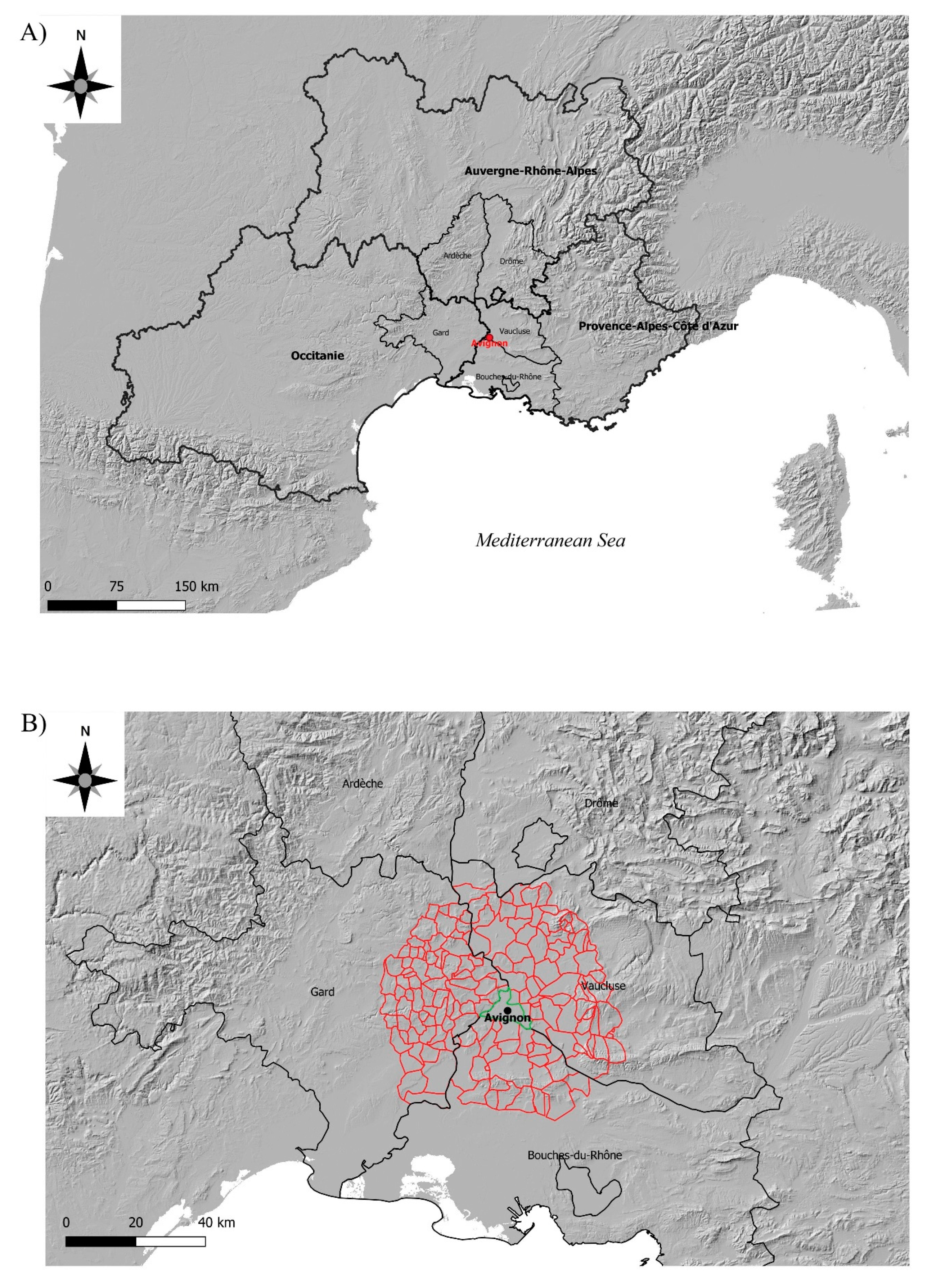
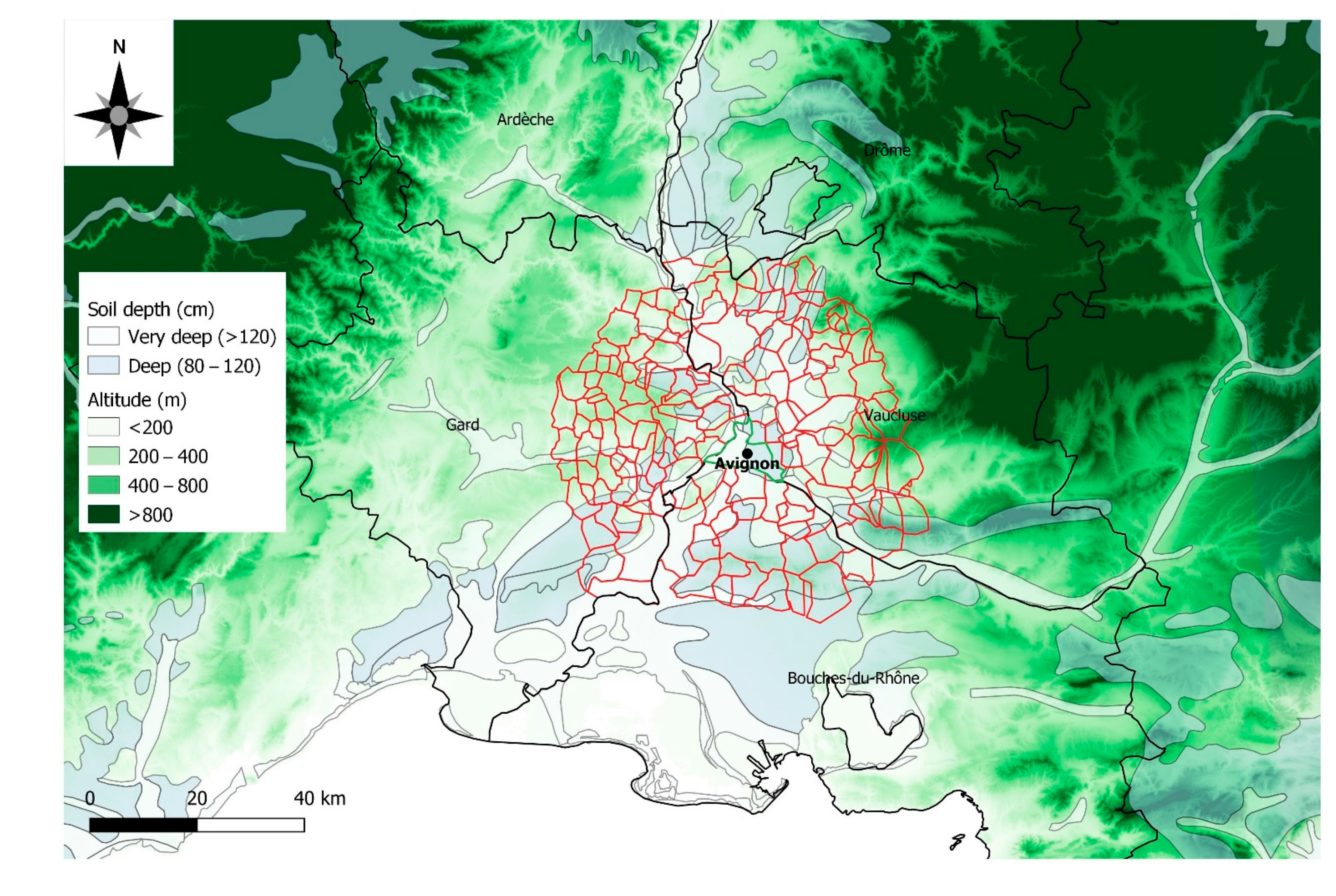
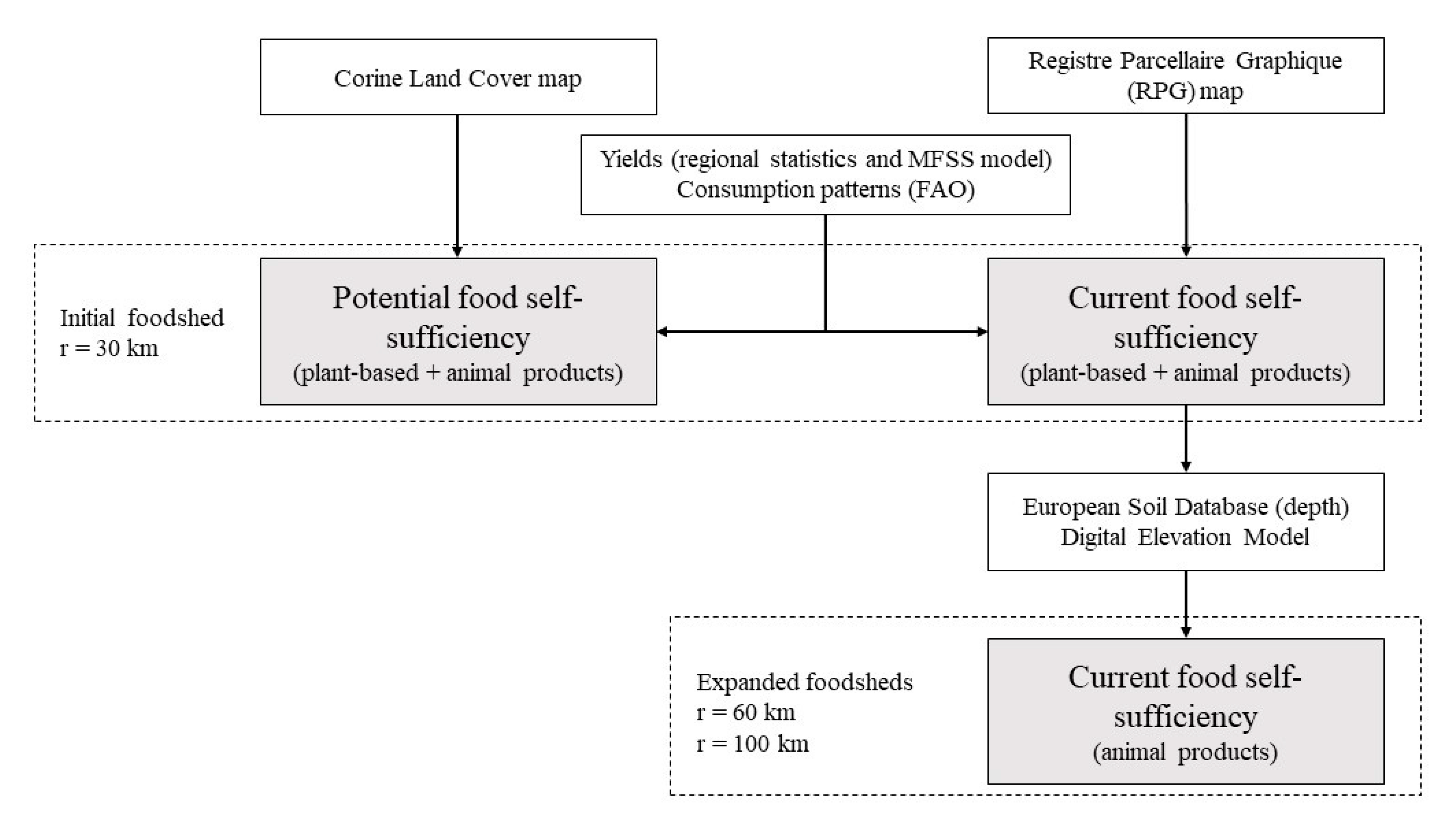
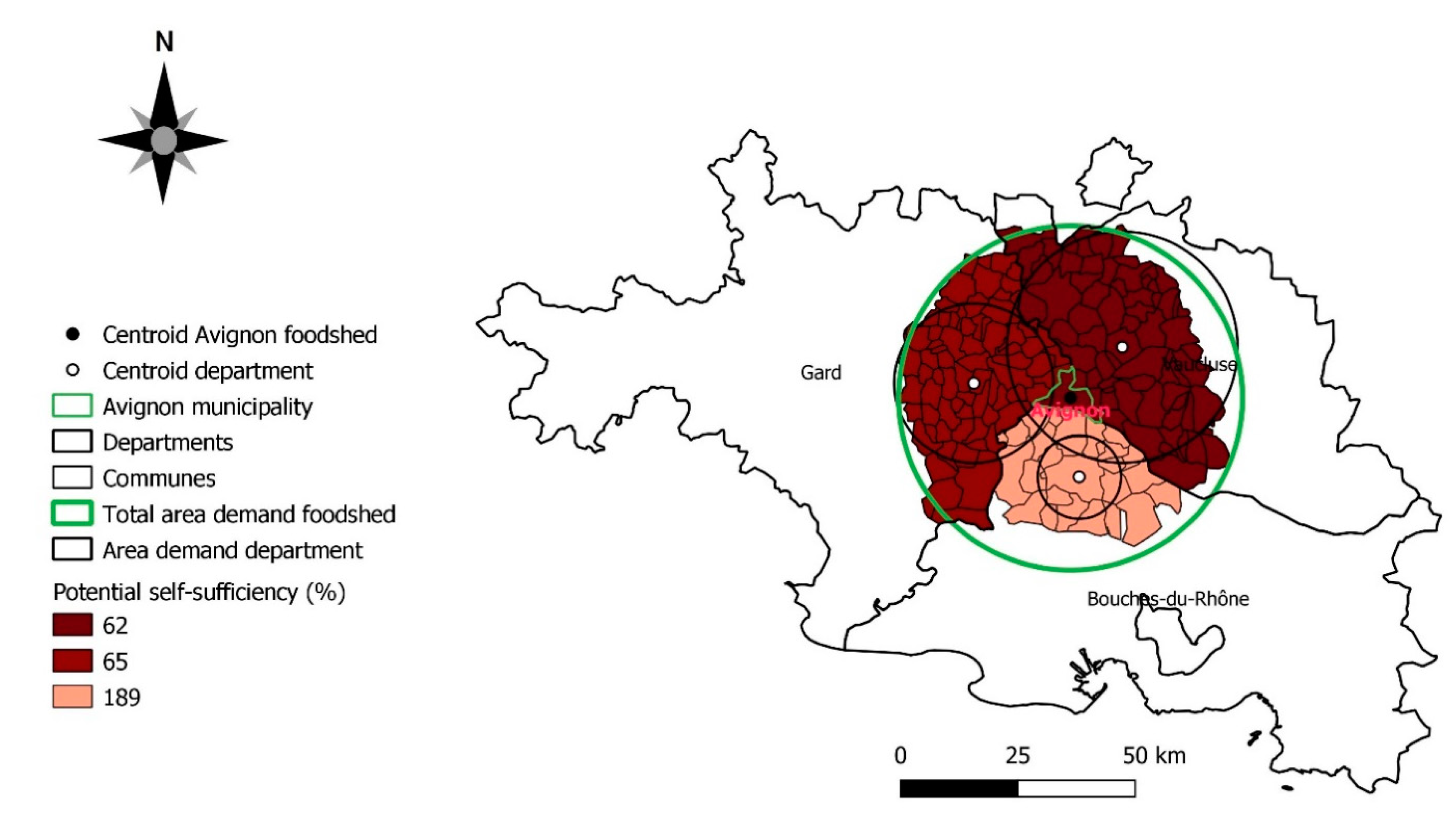
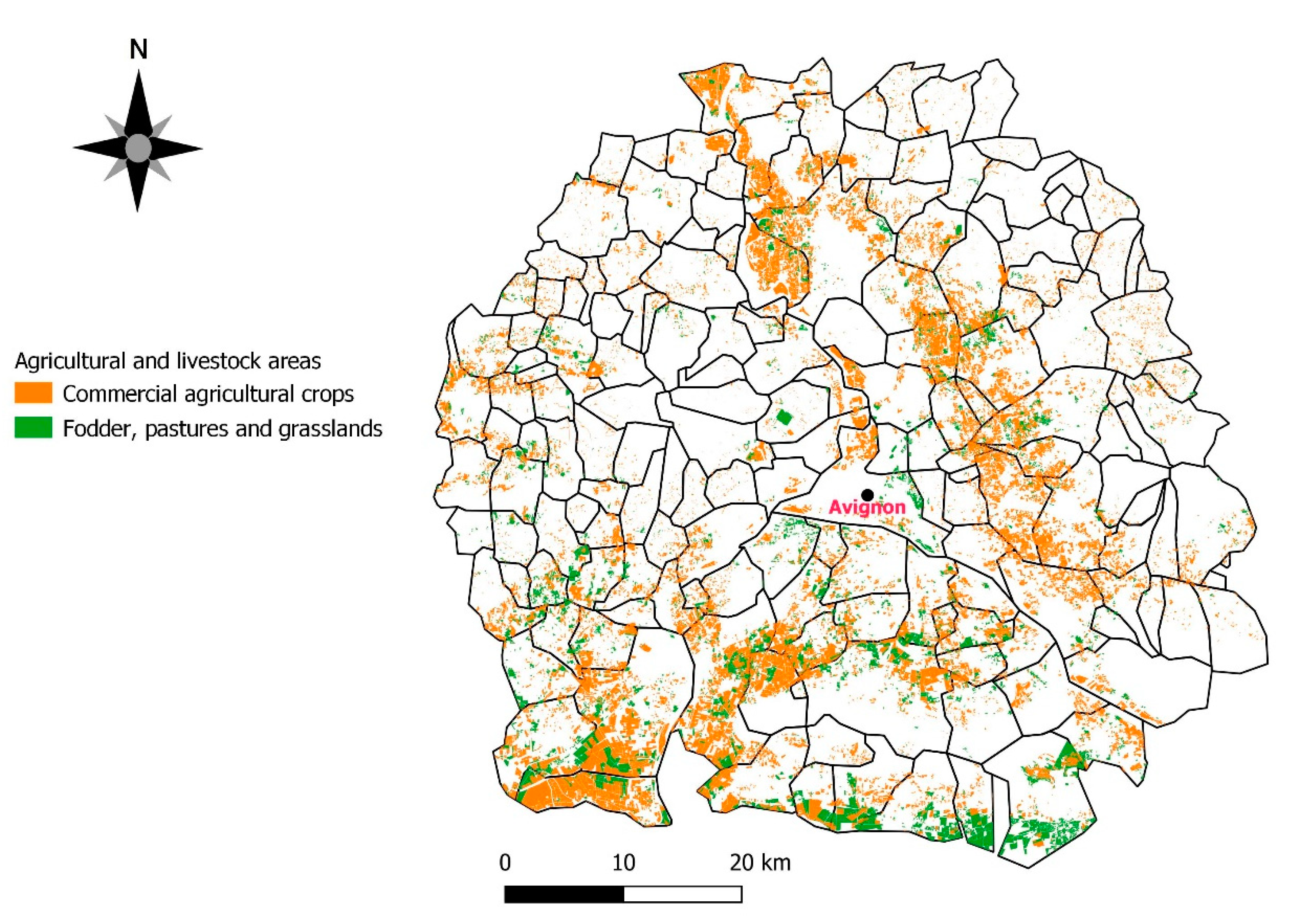
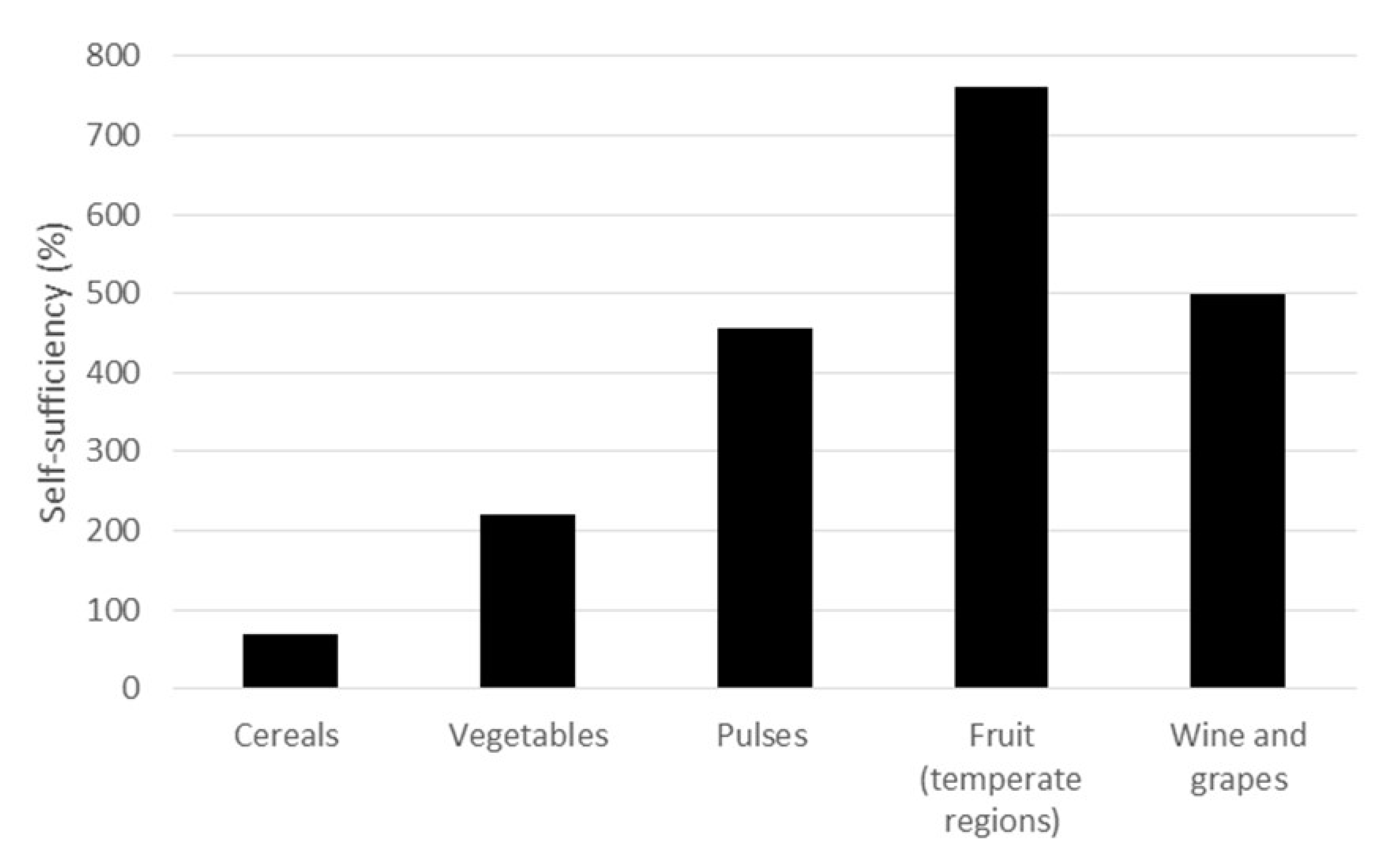
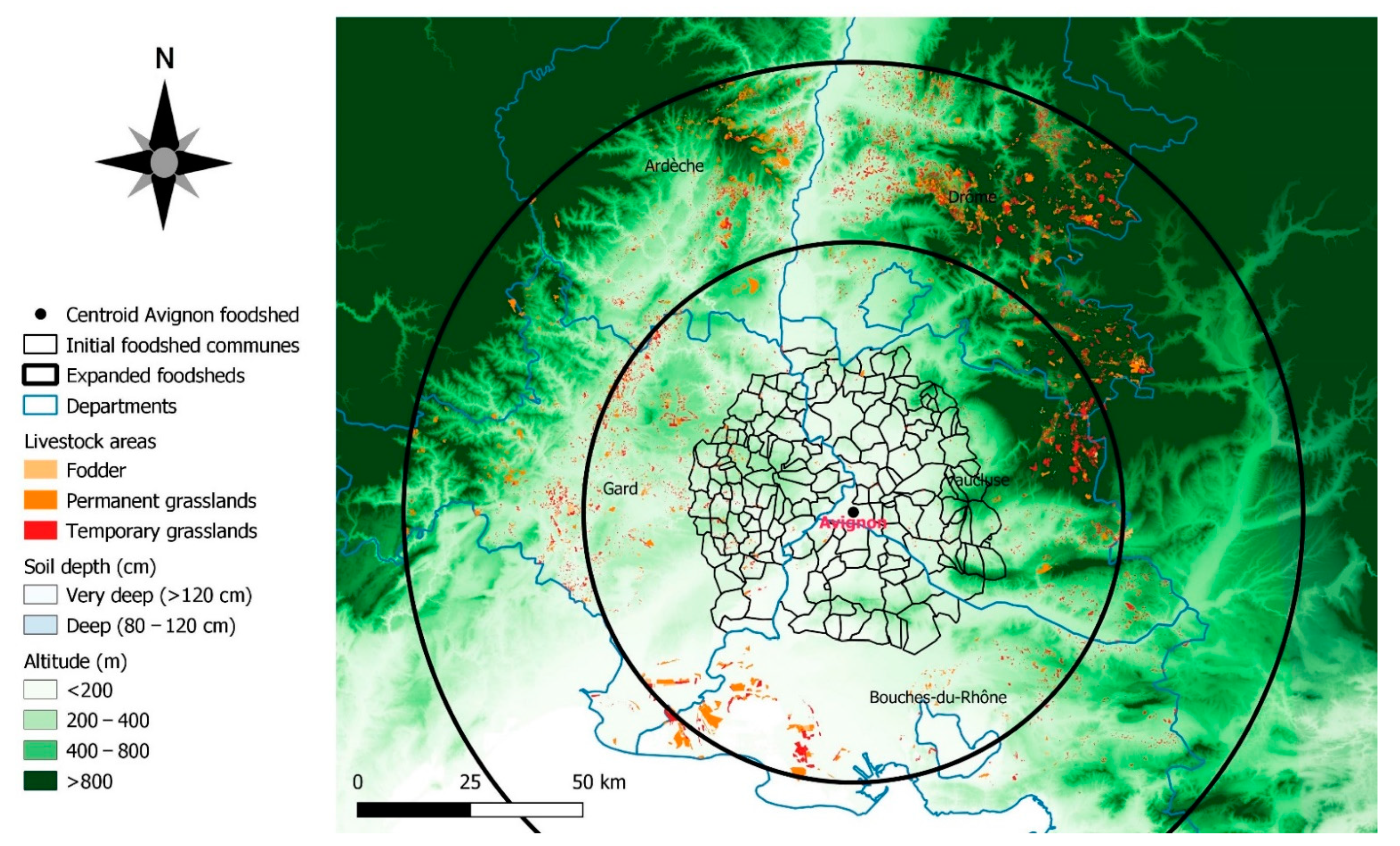
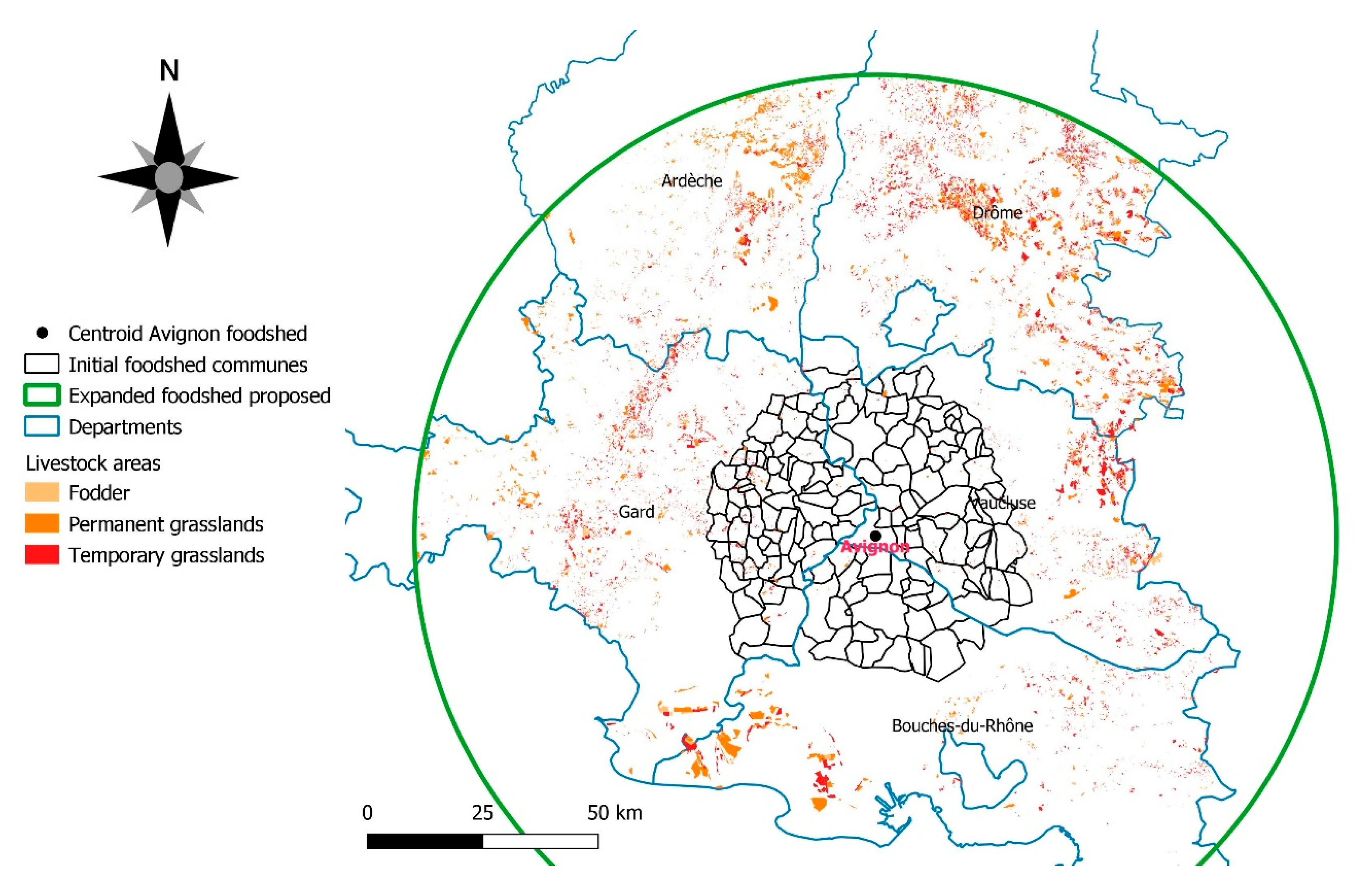
| Department | Total Area | UAA | Population Density | Total Area Demand | UAA per Capita | Area Demand per Capita | Radius | Self-Sufficiency |
|---|---|---|---|---|---|---|---|---|
| Bouches-du-Rhône | 77,556 | 44,792 | 150 | 23,752 | 3861 | - | 9 | 189 |
| Gard | 123,599 | 26,010 | 158 | 40,103 | 1328 | - | 17 | 65 |
| Vaucluse | 149,457 | 52,606 | 278 | 84,973 | 1268 | - | 25 | 62 |
| Foodshed | 350,613 | 123,408 | 207 | 148,827 | 1698 | 2047 | 37 | 83 |
| Product | Area Demand of Each Product | Total area Demand of Each Department | Current Area Used for Pastures and Fodder in the Foodshed | Current Self-Sufficiency |
|---|---|---|---|---|
| Beef | 34,787 | - | - | - |
| Eggs | 6034 | - | - | |
| Poultry | 13,483 | - | - | - |
| Pork | 24,023 | - | - | - |
| Milk and dairy | 51,484 | - | - | - |
| Mutton and goat | 3138 | - | - | - |
| Total | 132,950 | - | - | - |
| Department | ||||
| Bouches-du-Rhône | - | 21,218 | 6826 | 32 |
| Gard | - | 35,824 | 4300 | 12 |
| Vaucluse | - | 75,908 | 2994 | 4 |
| Total 30 km Foodshed | - | 132,950 | 14,120 | 11 |
Publisher’s Note: MDPI stays neutral with regard to jurisdictional claims in published maps and institutional affiliations. |
© 2021 by the authors. Licensee MDPI, Basel, Switzerland. This article is an open access article distributed under the terms and conditions of the Creative Commons Attribution (CC BY) license (http://creativecommons.org/licenses/by/4.0/).
Share and Cite
Vicente-Vicente, J.L.; Sanz-Sanz, E.; Napoléone, C.; Moulery, M.; Piorr, A. Foodshed, Agricultural Diversification and Self-Sufficiency Assessment: Beyond the Isotropic Circle Foodshed—A Case Study from Avignon (France). Agriculture 2021, 11, 143. https://doi.org/10.3390/agriculture11020143
Vicente-Vicente JL, Sanz-Sanz E, Napoléone C, Moulery M, Piorr A. Foodshed, Agricultural Diversification and Self-Sufficiency Assessment: Beyond the Isotropic Circle Foodshed—A Case Study from Avignon (France). Agriculture. 2021; 11(2):143. https://doi.org/10.3390/agriculture11020143
Chicago/Turabian StyleVicente-Vicente, José Luis, Esther Sanz-Sanz, Claude Napoléone, Michel Moulery, and Annette Piorr. 2021. "Foodshed, Agricultural Diversification and Self-Sufficiency Assessment: Beyond the Isotropic Circle Foodshed—A Case Study from Avignon (France)" Agriculture 11, no. 2: 143. https://doi.org/10.3390/agriculture11020143
APA StyleVicente-Vicente, J. L., Sanz-Sanz, E., Napoléone, C., Moulery, M., & Piorr, A. (2021). Foodshed, Agricultural Diversification and Self-Sufficiency Assessment: Beyond the Isotropic Circle Foodshed—A Case Study from Avignon (France). Agriculture, 11(2), 143. https://doi.org/10.3390/agriculture11020143






